Growing Up in Scotland: Birth Cohort 2. Results from the First Year
This Growing up in Scotland report provides a detailed insight into the first set of data collected from the study’s second birth cohort – representative of all children born in Scotland between 1st March 2010 and 28th February 2011 – around the time they were all aged 10 months old.
Chapter 2 Characteristics and circumstances of children and their families
Paul Bradshaw, ScotCen Social Research
2.1 Introduction
This chapter provides an overview of the circumstances and characteristics of children born in Scotland between 1st March 2010 and 28th February 2011, around the time they were aged 10 months old. Previous research using GUS data has demonstrated the important association between key parental and familial characteristics - such as maternal age, level of education, income and employment - and child outcomes in the early years. Therefore, understanding the current demographic and socio-economic characteristics of young children and their families - and how these have changed over the last six years - is crucial in interpreting patterns in the experiences and behaviours which follow in subsequent chapters.
A range of policy and wider, societal-level changes have occurred between the births of children in the two cohorts which we may expect to have created differences in some of the characteristics and circumstances of their families. Not least is the financial crisis which, since 2008, has affected employment and income levels of families in Scotland, the rest of the UK, and all over the world. Fundamentally therefore, the economic climate into which children in each cohort was born was dramatically different.
With reductions in employment, comes a greater reliance on benefits and tax credits to supplement income. For example, at around the time the first children in BC1 were being born in April 2004, approximately 1.5 million families in the UK were receiving Working and Child Tax Credits. By the time of the first births in BC2 in April 2010, this figure had risen to 1.9 million (HMRC, 2012).
Over the same period, changes to the eligibility criteria for many benefits have affected families. For example, the period for statutory maternity pay was increased from 26 to 39 weeks in April 2007, missed by mothers in BC1 but established ahead of BC2 births. In 2011, the thresholds for withdrawal of Tax Credits were lowered - removing these for moderate and higher income families - and Child Benefit amounts were frozen. At the same time, the child element of Child Tax Credit was increased helping to maintain award levels for families on lower than average incomes.
Beyond the economic situation there has also been notable demographic change. Migration into Scotland has been increasing since 2003, though with a slight drop in 2010-11 (GRO Scotland, 2012) particularly following the accession of the A8 countries - including Poland, Latvia, Czech Republic and Hungary - to the EU in 2004. Mother's age at the child's birth has also continued to change. Since the mid-1970s, first-time mothers have gradually been getting older. However, in the last five to 10 years this trend has slowed and started to reverse (ISD Scotland, 2011).
This chapter provides an overview of children's household and family arrangements, parental demographics (such as age and marital status) and socio-economic characteristics (such as income and tenure). In so doing, it illustrates the complex relationships between these measures which have been a common feature of earlier analysis of GUS data. It also allows a more detailed consideration of the impact of broader economic and demographic change on Scottish families.
2.2 Key findings
- The proportion of births to women in their thirties has decreased from 47% in 2004/05 to 44% in 2010/11. The main corresponding increase has been amongst mothers in their twenties, rising from 42% in 2004/05 to 45% in 2010/11. Births to teenage mothers also decreased from 8% to 6%.
- At 10 months of age, 79% of children lived with two parents whereas 21% lived with a single parent. These figures are almost identical to those for BC1 which were 80% and 20% respectively.
- 50% of parents were married, 29% were cohabiting and 19% were single, leaving only a small proportion either separated or divorced. Marriage had decreased - down from 54% - and cohabiting increased - up from 26% - since 2005.
- 33% of children were reported to have had between one and three grandparents alive, 53% had four grandparents, and 13% had more than four. Children in BC2 had slightly more grandparents alive at age 10 months than did children in BC1.
- Receipt of Working and Child Tax Credits is lower amongst families in BC2 compared with those in BC1 reflecting the lower thresholds for withdrawal of Tax Credits introduced in 2011. Receipt of Jobseeker's Allowance, Housing Benefit and Council Tax Benefit increased slightly.
- After taking account of inflation, the data suggest that families in 2011/12 have lower incomes than families with young children did in 2005/06. Whereas 21% of families in BC1 had an annual income of less than £10,833, the same was true (in real terms) for 27% of families in BC2.
- 57% of mothers were in some form of paid employment (including those on maternity leave). Mothers were more likely to be working part-time (40%) - defined as less than
35 hours per week - than full-time (17%) - defined as 35 hours per week or more.
There was little change in maternal employment status between the two cohorts. - Religious membership amongst children has decreased between the two cohorts.
In BC1, 41% of children were described as being part of a religion. In BC2, this
had decreased to 37%. - Most children (56%) lived in a property that was 'owner occupied' though the proportion of families in owner occupied homes has decreased (from 62% to 56%) whereas the proportion in private rented homes has increased (from 6% to 16%).
2.3 Family and parental characteristics
Maternal age at child's birth
The mothers of children born between March 2010 and February 2011 were, on average,
30 years old at the time of the child's birth. Mothers were thus most likely to be in their twenties or thirties. 45% of mothers were aged between 20 and 29 and 44% were aged between 30 and 39. In contrast, just 6% of mothers were aged under 20 at the child's birth and only 4% were 40 or older. The change between BC1 and BC2 to some extent reflects the patterns in ISD data noted in the introduction in that there has been some reduction in the proportion of births to women in their thirties - which has reduced from 47% to 44%. In addition, the proportion of births to teenagers has also decreased from 8% to 6%. The main corresponding increase has been amongst mothers in their twenties, rising from 42% in 2004/05 to 45% in 2010/11.
As was noted in relation to BC1, maternal age is associated with stark differences in socio-economic characteristics. For example, as shown in Figure 2.1, the majority (71%) of teenage mothers lived in households in the lowest income quintile, with most of the remainder in the second lowest group. Most mothers in their thirties however, lived in a household in one of the top two income groups.
Figure 2.1 Maternal age at child's birth by household equivalised income (quintiles)
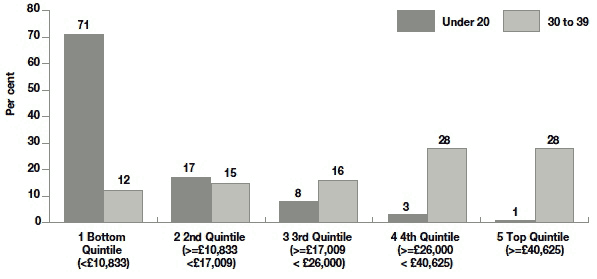
Base - all BC2 families with income information: under 20 = 287, 30 to 39 = 2636
Mothers aged under 30 were more likely than those who were older to live in areas of higher deprivation. As shown in Table 2.1, 42% of mothers aged under 20 and 29% of mothers aged between 20 and 29 lived in an area in the most deprived quintile compared with 17% of mothers in their thirties and 10% of those aged 40 or older.
Table 2.1 Maternal age by area deprivation (quintiles)
| Under 20 | 20 to 29 | 30 to 39 | 40 or older | |
|---|---|---|---|---|
| Area deprivation quintile | % | % | % | % |
| Least deprived quintile | 6 | 10 | 26 | 29 |
| 2 | 8 | 15 | 21 | 26 |
| 3 | 14 | 21 | 19 | 23 |
| 4 | 30 | 24 | 17 | 13 |
| Base: all BC2 families | 343 | 2552 | 2950 | 267 |
Maternal age was also associated with family type. 90% of mothers in their thirties and a similar proportion aged 40 or older (87%) were in couple families when the child was aged 10 months, compared with 74% of mothers in their twenties and 33% of those aged under 20.
By virtue of their age, younger mothers have had more limited opportunity to obtain higher educational qualifications such as university degrees or higher-level vocational qualifications. However, most teenage mothers had achieved good passes in school-level qualifications at either upper-level Standard Grades (48%) or Higher Grades (19%). Most mothers aged over 30 had, in contrast, achieved a degree-level qualification including 59% of those aged between 30 and 39, and 59% of those aged 40 or older.
Family type and marital status
At 10 months of age, 79% of children lived with two parents whereas 21% lived with a single parent. These figures are almost identical to those for BC1 which were 80% and 20% respectively.
As suggested above, lone parenthood is more common amongst younger mothers than older mothers, and is thus associated with similar socio-economic characteristics. Compared with couple families, lone parents are more likely to be in lower income groups, have lower educational qualifications and live in areas of higher deprivation. For example 59% of lone parent families had incomes in the lowest 20% compared with 14% of parents in couple families (Figure 2.2).
Figure 2.2 Family type by household equivalised income (quintiles)
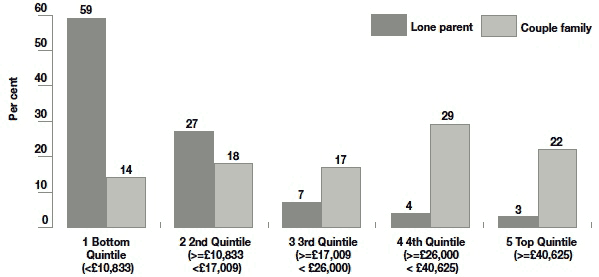
Base - all BC2 families with income information: lone parent = 972, couple family = 4437
Being a couple family does not necessarily mean that the child resides with both biological parents. As such, the figure for lone parent families used here can disguise the proportion of children who are actually living apart from a biological parent. In practice however, at this early age, in the vast majority of cases where the main carer lives with a partner, both are biological parents. Indeed, in 99% of couple families this was the case. Overall, 78% of children lived with both biological parents and 22% with just one.
50% of parents were married, 29% were cohabiting and 19% were single, leaving only a small proportion either separated or divorced. The main changes between the two cohorts were a slight decrease in the proportion of parents who were married - down from 54% - and a corresponding increase in the proportion cohabiting, up from 26%.
Number of children
In 46% of families, the cohort child was the only child in the household. 37% of families had two children, leaving a smaller proportion of larger families with three (13%) or more (4%). Families in 2011 had marginally fewer children than did families in 2005 (see Table 2.2); 83% of families in BC2 had just one or two children compared with 81% of families in BC1.
Table 2.2 Number of children in household by cohort
| Birth cohort 1 | Birth cohort 2 | |
|---|---|---|
| Number of children in household | % | % |
| 1 | 47 | 46 |
| 2 | 34 | 37 |
| 3 | 14 | 13 |
| 4 or more | 5 | 4 |
| Base: all families | 5217 | 6127 |
The number of children in a family varied significantly according to a range of social and demographic characteristics. As may be expected, children with younger mothers tended to have a smaller number of siblings - 81% of children whose mother was aged under 20 were an only child compared with 37% of children whose mother was in her thirties. Families in more disadvantaged circumstances tended to have a greater number of children. For example, 24% of families where the parents had no qualifications, and 26% of families where parents had lower-level Standard Grades had three or more children compared with 17% of families where parents had Higher Grades and 14% of families where parents had a degree-level qualification. Similarly, between 20% and 25% of families in each of the bottom three income groups had three or more children compared with 12% in the second highest and just 6% in the highest income group.
Such stark variations did not exist according to area deprivation, though the proportion of families with three or more children was higher in the most deprived quintile (22% compared with 15%-17% in all other areas). Geographic variations were also evident according to the urban-rural classification of the area in which the family lived. As shown in Figure 2.3, families living in remote rural areas were larger than those in all other areas, and those living in large urban areas smaller. 24% of families in remote rural areas had three or more children compared with 16% of families in large urban areas. Notably, there is no gradual trend of increasing numbers of children with increasing rurality or remoteness. Figures for families living in accessible rural areas, and in small, remote towns are similar to those living in large urban areas.
Figure 2.3 Number of children in household by area urban-rural classification
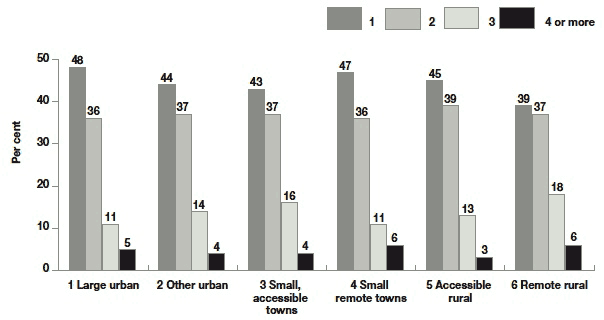
Base - all BC2 families: large urban = 2274, other urban = 1780, small accessible towns = 493, small remote towns = 248, accessible rural = 977, remote rural = 354
In households with other children, the vast majority were natural siblings of the cohort child. However, in 10% of households the child lived with either a step or half-sibling. The proportion of children living with a step or half-sibling at this age has increased from 8% in BC1, suggesting a very slight rise in 'blended' families since 2005.
Grandparents
33% of children were reported to have had between one and three grandparents alive,
53% had four grandparents, and 13% had more than four. Children in BC2 had slightly more grandparents alive at age 10 months than did children in BC1. Only 4% of children in BC1 were reported to have more than four grandparents, 56% had four and 39% had between
one and three. A grandparent lived with the child in 6% of families; this figure was almost identical to the 7% for BC1[5].
The reporting of more than four grandparents tends to be associated with blended families where the parents of a child's step-parent become recognised as grandparents in the new family group alongside the parents of both biological parents. Whilst the data in the previous section suggested an increase in the number of blended families between cohorts, the rise does not appear large enough to have influenced this corresponding increase in the proportion of children with a large number of grandparents. Further examination of data collected on grandparents and their relationship with the child and family is included in chapter 5.
As may be expected, maternal age was a key factor associated with the number of grandparents the child was reported to have. 65% of children whose mothers were aged under 30 had four grandparents alive compared with 50% of children whose mother was in her thirties (at the child's birth) and 24% of those whose mother was in her forties.
Patterns by socio-economic characteristics were varied. However, children in more disadvantaged circumstances tended to have fewer grandparents alive. For example, 57% of children living in an area in the least deprived quintile had four grandparents compared with 48% of those living in the most deprived areas (Figure 2.4). Patterns were similar when comparing lower and higher income groups, and parents with no qualifications with those who have any qualifications.
Figure 2.4 Number of grandparents alive by area deprivation (quintiles)
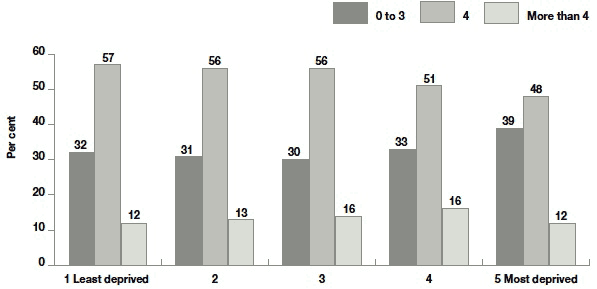
Base - all BC2 families: least deprived = 1155, 2nd quintile = 1172, 3rd quintile = 1272, 4th quintile = 1233, most deprived = 1284
Having a resident grandparent is also heavily influenced by maternal age. 34% of children whose mother was under 20 lived in the same household as a grandparent compared with 7% of those with mothers in their twenties and just 2% of mothers aged 30 or older. For younger mothers, this is mostly the case because they are still living in their parent's home.
Patterns by other parental characteristics largely reflect the situations of younger mothers. Resident grandparents are more common in lone parent households (21% compared with 3% of couple households) and in lower income households. In relation to income, the main distinction is between those in the lowest income group (15%) and all other income groups (between 4% in the second lowest group and 1% in the highest income group).
2.4 Income
Sources of income
Parents were asked to provide information on different sources of income such as wages from employment and benefits. A summary of the proportion of families with different types of income is illustrated in Figure 2.5 which also provides a comparison between BC1 and BC2.
Figure 2.5 Proportion of families with any of these sources of income by cohort
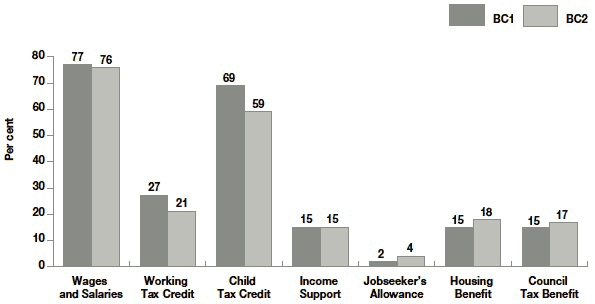
Base - all families: BC1 = 5202, BC2 = 6108
For families in both cohorts, income was most likely to come from wages and salaries, and Child Tax Credit. The proportion of families receiving wages from employment, and thus - as will be shown below - having a parent in employment - is virtually identical in both cohorts. However, there have been some notable changes. For example, receipt of Working and Child Tax Credits is lower amongst families in BC2 compared with those in BC1 - though the majority of families in BC2 continue to receive some Child Tax Credit. This reduction reflects the lower thresholds for withdrawal of Tax Credits introduced in 2011. On the other hand, receipt of Jobseeker's Allowance, Housing Benefit and Council Tax Benefit has increased slightly, being higher amongst BC2 families than BC1 families.
Annual household income
Overall income is measured at a household level and before tax. Parents are asked to provide the amount of income they receive from all sources including earnings, benefits, tax credits, interest from savings and so on. Figures can be given as either weekly, monthly or annual amounts.
After all amounts are adjusted to produce an annual income, the figures are then 'equivalised' to allow for the size and composition of the household, as these affect the income required to attain a particular standard of living. For example, a couple with dependent children will need a higher income than a single person with no children to attain the same material living standards. Equivalised amounts are then divided into five equal groups (quintiles)[6].
Table 2.3 Equivalised annual household income (quintiles) by cohort
| Birth cohort 1 | Birth cohort 2 | |||
|---|---|---|---|---|
| Equivalised annual household income | % | % | 2005/06 amounts at 2011/12 prices |
% |
| Bottom Quintile (<£10,833) | 21 | 23 | <£12,582 | 27 |
| 2nd Quintile (>=£10,833 <£17,009) | 21 | 20 | >=£12,582 <£19,559 |
23 |
| 3rd Quintile (>=£17,009 < £26,000) |
18 | 15 | >=£19,559 < £29,681 |
16 |
| 4th Quintile (>=£26,000 < £40,625) |
21 | 24 | >=£29,681 < £46,633 |
21 |
| Top Quintile (>=£40,625) | 19 | 18 | >=£46,633 | 13 |
| Base: all families | 4682 | 5408 | 5408 | |
Table 2.3 compares the income levels of families in both cohorts allowing some consideration of how these have changed over time. To allow a comparison of change in income in real terms, it is necessary to convert the 2005/06 amounts used as cut-offs to their equivalent in 2011/12 prices after taking account of inflation[7]. For example, as shown in row four of the table, £10,833 in 2005/06 is equivalent to £12,582 in 2011/12. That is, to purchase something which cost £10,833 in 2005/06 would require £12,582 in 2011/12.
After taking account of inflation, the data suggest that families in 2011/12 have lower incomes than families with young children did in 2005/06. Whereas 21% of families in BC1 had an annual income of less than £10,833, the same was true (in real terms) for 27% of families in BC2. There is also a significant decrease in the proportion of families in the top income group - earning more than £40,624 - dropping from 19% to 13%.
These results should be interpreted with caution. Over the same period, Scottish Government income inequality data indicate a seemingly opposite trend; child poverty statistics show small reductions in the proportion of children living in poverty, from 21% to 17% for relative poverty, and from 12% to 10% for absolute poverty (Scottish Government, 2012). GUS data refers to a more specific population of families than do the official poverty statistics and may thus reflect trends amongst that precise population. In addition, the incomes of families in BC2 may be on the whole lower due to more extended periods of maternity leave (and the lower income received during that time) taken by mothers in BC2 compared with BC1, as will be shown in chapter 8.
2.5 Financial management and material deprivation
Financial management
Questions on parents' financial management asked whether they had a bank account and savings, how they were coping financially - including any trouble with debts - and whether their situation had got better or worse in the last 12 months.
Almost all parents (97%) had a bank account and a little under half (47%) said they had money saved or invested. Parents in more disadvantaged circumstances were less likely to have a bank account, but differences were small. For example, 94% mothers under 20 at the time of the child's birth did not have a bank account compared with 98% of mothers in their thirties. Similarly, 91% of parents with no educational qualifications had a bank account compared with 99% of degree-educated parents. The trend was similar in relation to savings, but with bigger differences. Around twice the proportion of mothers aged 40 or older had money saved or invested as those in their twenties (68% compared with 37%).
Most families (66%) never had trouble with debts. However, 21% sometimes did, 9% did so quite often and 4% had debt trouble almost all the time. Debt trouble was more common amongst, but not confined to, lower income families. Amongst families in the lowest income group 9% had trouble with debts almost all the time and 17% quite often compared with 1% and 3% in the highest income group.
In terms of coping financially, parents tended to say they were either managing quite well (33%) or getting by alright (43%). However, a small proportion said they didn't manage very well (4%) or were in financial difficulty or deep financial trouble (7%).
37% of parents said that, in the last year, their financial situation had got worse. For 15% it had got better, and for 49% it had stayed the same. Amongst those for whom it had got worse (n = 2237), the main reason given was that they were managing on less money (48%), fewer said it was because they had to buy more (14%). Although many cited both reasons (29%) and others said it was due to a rise in the cost of living (9%).
Material deprivation
In the last decade, governments in the UK have increasingly adopted multiple ways of measuring poverty, moving away from a reliance on income alone. One of these alternative methods is consideration of the extent to which a family has been deprived of certain 'essential' items or activities. An index of material deprivation was first developed by the Department for Work and Pensions and has been incorporated into Government measures of child poverty.
Material deprivation in GUS is measured using eight items derived from the various, longer DWP scales which have been developed and used in a number of surveys, including previous sweeps of GUS, over the last 10 years. The items are detailed below:
- Do you have a holiday away from home for at least one week a year, whilst not staying with relatives at their home?
- Do you have a celebration with presents, for friends and family at special occasions like birthdays?
- Do you have a night out once a month?
- Do you and your family have a car/van?
- Do you have enough money to keep your home in a decent state of decoration?
- Do you have household contents insurance?
- Do you make regular savings of £10 a month or more for rainy days or retirement?
- In winter, are you able to keep this accommodation warm enough?
For each item, except the last, the response items were: we do this; we would like to do this but cannot afford it at the moment; we do not want/need this at the moment. For the last item the response was a simple yes or no.
To create a score of material deprivation, on the first seven items the response 'we would like to do this but cannot afford it' was given the value of one. All other responses were coded zero. On the last item, the answer 'no' was given the value of one, and 'yes' was coded as zero. The score was a sum of all responses coded as one, with a maximum of eight and a minimum of zero.
43% of families scored zero and a further 19% scored just one meaning that most families (62%) reported little material deprivation. However, a significant minority, 14%, scored four
or more suggesting quite high levels of material deprivation.
Material deprivation was higher in, but not restricted to, those sub-groups which have already been shown to be income deprived (Table 2.4). For example, 34% of teenage mothers scored 4 or more on the index compared with 9% of mothers in their thirties.
34% of families in the bottom income group scored 2 or 3 compared 7% in the highest income group.
Table 2.4 Material deprivation score (banded) by selected family characteristics
| Score on material deprivation index | Base: All families with a valid response to all material deprivation items | ||||
|---|---|---|---|---|---|
| 0 | 1 | 2 or 3 | 4 or more | ||
| Maternal age at child's birth | |||||
| Under 20 | 14 | 18 | 33 | 34 | 262 |
| 30 to 39 | 54 | 20 | 18 | 9 | 2841 |
| Family type | |||||
| Lone parent | 15 | 16 | 33 | 36 | 964 |
| Couple family | 50 | 20 | 21 | 9 | 4776 |
| Equivalised annual household income | |||||
| Bottom Quintile (<£10,833) | 12 | 16 | 34 | 37 | 1002 |
| Top Quintile (>=£40,625) | 79 | 13 | 7 | 1 | 1037 |
| Area deprivation | |||||
| Most deprived | 25 | 16 | 32 | 27 | 1090 |
| Least deprived | 65 | 19 | 13 | 3 | 1195 |
2.6 Employment and socio-economic classification
Employment status of mothers
At the time of the interview, 57% of mothers were in some form of paid employment (including those on maternity leave). Mothers were more likely to be working part-time (40%) - defined as less than 35 hours per week - than full-time (17%) - defined as 35 hours per week or more.
As shown in Figure 2.6, there was little change in maternal employment status between the two cohorts. In 2005/06, 58% of mothers were currently employed including 15% who were working full-time and 43% who were working part-time.
Figure 2.6 Mother's employment status at the time of the interview by cohort
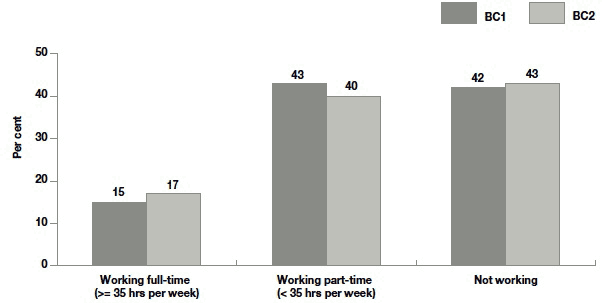
Base - all households where child's mother was resident: BC1 = 5199, BC2 = 6104
Changes to maternity leave entitlement introduced between the birth of children in each cohort meant that mothers in BC2 took longer periods of maternity leave than mothers in BC1 (see chapter 8). Mothers in BC2 were also more likely to still be on maternity leave at the time of the interview than mothers in BC1 (17% compared with 9%). As those mothers still on leave gave details of their employment prior to going on leave, and were more likely to therefore report a full-time rather than part-time position, the comparison was re-run excluding those cases still on leave (thus including only those who had returned to work or were not employed). This analysis provided more differentiation between the cohorts. Mothers in BC2, while just as likely to work full-time (20% compared with 20% in BC2), they were less likely to be working part-time and more likely to be not working than those in BC1 (60% and 20% compared with 65% and 14% in BC1 respectively).
Younger mothers and lone mothers were less likely to be in employment than were older mothers and those in couple families. For example, 74% of mothers who were teenagers at the time of the child's birth were employed when the child was aged 10 months compared with 48% of those in their twenties and 31% of those in their thirties. Almost twice as many lone mothers as mothers in couple families were not working (68% compared with 35%).
Socio-economic classification
Figure 2.7 illustrates the spread of National Statistics Socio-economic Classification (NS-SEC), measured at household level, by cohort. There has been very little change between the two cohorts. For both cohorts, the largest, single group was those in managerial or professional occupations, followed by those in semi-routine and routine occupations. Only very small proportions of households were classed as small employers and own account workers, in lower supervisory and technical occupations or had never worked.
Figure 2.7 Household socio-economic classification (NS-SEC) by cohort
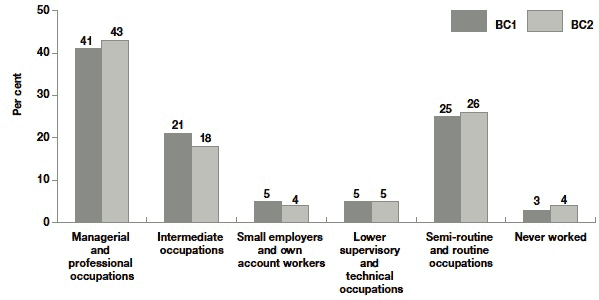
Base - all families: BC1 = 5210, BC2 = 6118
2.7 Religion, ethnicity and country of birth
Religion
Information was collected on religious affiliation of the child and parents. The majority of children (63%) did not belong to a religion, religious denomination or body. Similar proportions of children belonged to the Church of Scotland (14%) and Roman Catholic (14%) faiths with a further small proportion (4%) following other Christian faiths. 2% were Muslims and 2% belonged to another non-Christian religion.
Religious membership amongst children has decreased between the two cohorts. In BC1, 41% of children were described as being part of a religion. In BC2, this had decreased to 37%.
In those cases where children belonged to a religion, parents were asked how often the child attended related meetings or services. 48% said they very rarely or never attended, 14% attended less often than once a month, 15% around once a month and 23% at least once a week.
Ethnicity
Almost all children were white with 5% being of minority ethnic background. These figures are almost identical to those for BC1 and reflect patterns in ethnicity amongst the general Scottish population.
Children from minority ethnic backgrounds were significantly more likely to be living in more disadvantaged circumstances than were white children, at least on some indicators. For example, 36% of minority ethnic children had annual household incomes in the lowest quintiles compared with 22% of white children. However, children in both groups were just as likely to be living in areas in the most deprived quintile (24%). In addition, whilst children from minority ethnic backgrounds were twice as likely to have carers with no educational qualifications (11% compared with 5% for white children), they were also more likely to have a carer educated to degree level (50% compared with 40% amongst white children).
Country of birth
Almost all children (99%) were born in Scotland. Those who were not were mainly born in England, with just a small number born outside of the UK.
In contrast, a little over one-fifth (22%) of main carers were born outside of Scotland (Figure 2.8). This proportion had increased from 17% since 2005/06. The change was mainly accounted for by an increase in the proportion of parents who were born outside of the UK. With no corresponding increase in the proportion of parents from minority ethnic groups (suggesting influx from Asian or African countries) and - as will be shown below - with Polish emerging as the most common language spoken after English, these parents therefore appear to represent those who have migrated from the predominantly white European A8 countries - such as Poland, Latvia, Czech Republic and Hungary - since the accession of these countries to the EU in 2004.
Figure 2.8 Main carer's country of birth by cohort
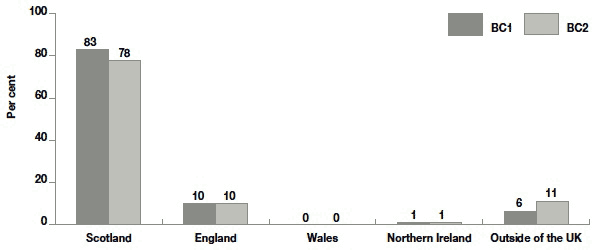
Base - all families: BC1 = 5213, BC2 = 6115
Languages spoken at home
Parents were asked if English was the only language in the household, whether other languages were also used, or if no English was used. Reflecting the ethnicity and migration data seen above, English was the only language spoken in the vast majority of households (91%). 7% of families used both English and at least one other language, whilst just 2% spoke no English at home.
There was some small, but statistically significant, change between the cohorts. The proportion of households where only English was spoken decreased from 94% whereas those speaking English and another language, and no English each increased, from 5% and 1% respectively.
Polish was the most prevalent single other language, being spoken in 3% of all households and 31% of those where any other language was spoken. The South-Asian languages of Urdu and Punjabi were spoken in around 1% of all households and 10% of the households where any other language was used. All other languages, including Gaelic, were used by less than 1% of families.
2.8 Area and housing
Urban-rural classification
Each family's address was assigned an urban/rural status according to the Scottish Government's six-fold Urban/Rural Classification. The spread of families across the various urban and rural areas is shown in Figure 2.9.
Figure 2.9 Household urban/rural classification
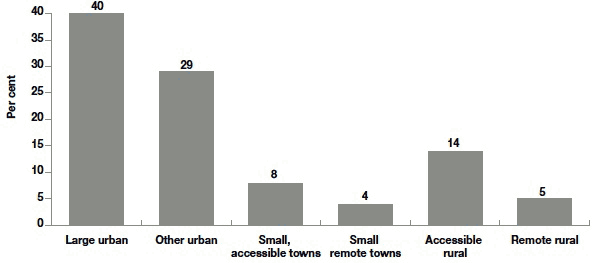
Base - all families: BC1 = 5213, BC2 = 6115
Most families (69%) were living in urban areas, with 19% living in rural areas and 12% living in small towns. 91% of families lived in areas broadly classed as 'accessible' (that is all categories except remote towns and remote rural) whereas 9% lived in remote areas. The results do not differ significantly from BC1 and relate very closely to whole population patterns in urban/rural characteristics (Scottish Government, 2012b).
Neighbourhood
To measure satisfaction with their local neighbourhood, parents were simply asked how satisfied or dissatisfied they were with the area they lived in. They were also asked how much they agreed or disagreed with a series of statements about the local area:
- "If I was able to, I would like to live in another neighbourhood"
- "This is a good area to bring children up in"
The vast majority (84%) of parents were satisfied with where they were living, including 48% who were very satisfied and 36% who were fairly satisfied. Only 4% were very dissatisfied whereas 6% were fairly dissatisfied.
Results from the two agree/disagree statements are shown in Figure 2.10. Most parents agreed that they lived in an area that was good for bringing up children (76%) and half (50%) did not want to live in another neighbourhood. However, 40% agreed that they would like to live elsewhere, and 13% disagreed that their local area was good for children.
Figure 2.10 Level of agreement and disagreement with statements on neighbourhood
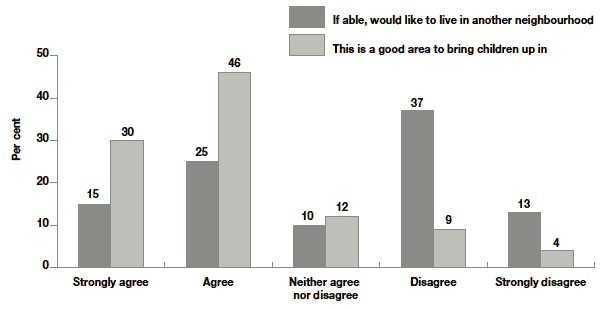
Base - all BC2 families: n = 6113
As may be expected, parents' perceptions of their neighbourhood were associated with broader area measures such as deprivation and urban-rural classification.
Satisfaction increased as area deprivation decreased. Three-quarters (75%) of parents living in areas in the least deprived quintiles were very satisfied compared with one-quarter (25%) of those living in areas in the most deprived quintile. The other measures followed a similar pattern. Differences in relation to area child-friendliness were particularly stark, though high area deprivation did not always equal poor child friendliness. For example, 50% of parents living in the most deprived areas agreed their neighbourhood was good for bringing up children. Nevertheless, 95% of parents living in the least deprived areas said the same.
Those in rural areas were more likely than those in urban areas or small towns to be very satisfied with their local neighbourhood. For example, 62% of parents in accessible rural areas were very satisfied with their local area compared with 44% in large, urban areas. Trends on the other measures were similar with those living in rural areas tending to perceive their local area more favourably.
In addition to information on parents' perceptions of their neighbourhood, survey interviewers also answered a series of questions based on their observations of the area surrounding each child's home. These questions covered the condition of residential properties in the area and the presence of unsightly features such as boarded houses, litter and graffiti.
Interviewers reported the conditions of a little under half of all residential properties to be good (47%) and a similar proportion to be fair (48%) with only a small proportion being bad or very bad (5%). The condition of properties deteriorated significantly as area deprivation increased (Figure 2.11). 80% of properties in the least deprived areas were said to be in good condition compared with 15% in the most deprived areas.
Figure 2.11 Conditions of residential properties in area as observed by interviewers by area deprivation
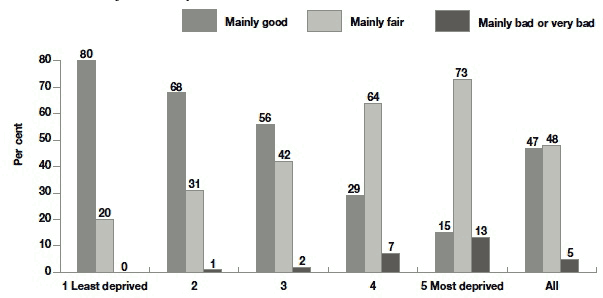
Base - all BC2 cases where observations made: n = 6127
At least one unsightly feature was observed by interviewers in the local area in relation to 14% of households. Litter or junk in the street was most common, being reported for 11% of cases. Graffiti (5%) and boarded up, abandoned or demolished buildings (4%) were less common. All were more prevalent in deprived than non-deprived areas, though the occurrence of the last two items was generally low across all areas. For example, graffiti was observed local to 13% of households in the most deprived areas and less than 1% in the least deprived areas. However, litter or junk was reported local to 28% of households in the most deprived areas compared with 1% in the least deprived areas.
Accommodation details
Most children lived in a house (68%), though many lived in a flat or maisonette (32%). These arrangements were identical across the two cohorts.
31% of children lived in accommodation which had six or more rooms (not including bathrooms or hallways), 30% with five rooms and 33% with four rooms. Only a small proportion (6%) lived in accommodation with less than four rooms.
63% of children had their own bedroom, a proportion similar to that for BC1 (62%). Of those who did not (n = 2183), around two-thirds (66%) shared with their parents and one-third (34%) shared with a sibling.
Virtually all homes (97%) had some form of central heating with most (82%) using gas. The vast majority of parents (94%) said they were able to keep their home warm enough during the winter, though the proportion was lower amongst those in more disadvantaged circumstances.
Parents were asked whether there were any repairs needing done on the family home. As shown in Table 2.5, three-quarters of parents said no repairs were required meaning 26% of homes required at least one repair. The most common repair mentioned was window replacement, though problems caused by draughts and from water ingress were reported in similar proportions. Repairs associated with plumbing and electrics, and with insects or vermin were less common.
Table 2.5 Repairs required to family home
| Repair required | % |
|---|---|
| None | 74 |
| Windows need replacing | 8 |
| Draughts | 7 |
| Water getting in from roof, gutters or windows | 6 |
| Bad condensation problems | 5 |
| Rising damp in floor and walls | 5 |
| Other | 5 |
| Problems with mould growth | 4 |
| Electrical wiring | 3 |
| Plumbing | 3 |
| Problems with insects | 2 |
| Problems with mice/rats | 2 |
| General rot and decay | 1 |
| Base | 6127 |
13% of families needed one repair on their home, 6% needed two and 6% needed three or more. Families living in areas of higher deprivation were more likely to need multiple repairs on their home. 16% of those living in areas in the highest deprivation quintile required two or more repairs compared with 7% living in areas in the lowest deprivation quintile.
Tenure
Most children (56%) lived in a property that was 'owner occupied'. That is it was either being purchased using a mortgage or loan or was already owned outright. 26% lived in homes that were being rented from the local authority or a housing association, 16% were in private rented homes and 3% had some other tenure arrangement (such as living rent free).
There has been significant change in tenure characteristics between the two cohorts (Figure 2.12). In particular, the proportion of families in owner occupied homes has decreased (from 62% to 56%) whereas the proportion in private rented homes has increased (from 6% to 16%).
Figure 2.12 Housing tenure by cohort
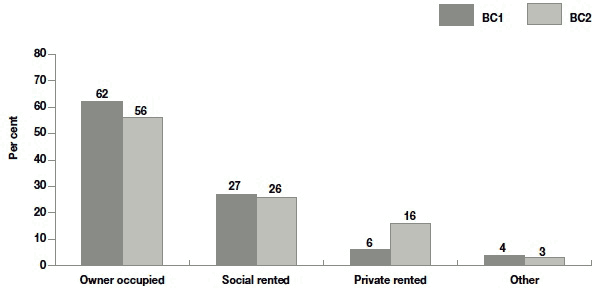
Base - all families: BC1 = 5210, BC2 = 6106
2.9 Summary
In terms of their family characteristics and circumstances, it seems that much has changed for children born in Scotland in 2010/2011 compared with those who were born six years earlier. Yet, many aspects of family life are also very similar between the two groups.
Much of the change noted reflects the broad policy and societal changes discussed in the introduction. The financial crisis, for example, has clearly had an impact on family incomes with a greater proportion of families getting by on lower incomes (in real terms) now than previously. Small increases in receipt of key benefits such as jobseeker's allowance, council tax and housing benefit were also evident.
These changes in income do not appear to have resulted from a decrease in levels of parental employment which were similar in both cohorts. This seems unusual given that employment is the main source of income for most families. It is possible that further, more detailed, analysis would therefore show a change in the occupations of parents and /or differences in wage levels which may explain this apparent contradiction.
There have been knock-on effects on housing tenure. Greater numbers of families in rented properties suggests that many more are having difficulty getting a mortgage or finding suitable homes at affordable prices.
Demographic change is also evident. Mothers in BC2 were, on average, slightly younger than those in BC1, mirroring trends noted elsewhere. Whilst there has been no significant change in ethnicity, more parents in BC2 were born outside of the UK and slightly more children live in bilingual households, with Polish in particular emerging as a more common spoken language.
2.10 References
GRO Scotland (2012) High Level Summary of Statistics: Population and Migration
http://www.gro-scotland.gov.uk/files2/stats/high-level-summary/j11198/j1119800.htm
HMRC (2012) Child and Working Tax Credits Statistics, London: National Statistics
http://www.hmrc.gov.uk/stats/personal-tax-credits/cwtc-main-apr12.pdf
ISD (2011) Births in Scottish Hospitals, year ending 31 March 2010, Edinburgh: ISD Scotland http://www.isdscotland.org/Health-Topics/Maternity-and-Births/Publications/2011-08-30/2011-08-30-Births-Report.pdf?
Scottish Government (2012a) Poverty and income inequality in Scotland: 2010-11, Edinburgh: Scottish Government
Scottish Government (2012b) Urban Rural Classification 2011-2012 Population Tables, Edinburgh: Scottish Government
Contact
Email: Sharon Glen
There is a problem
Thanks for your feedback